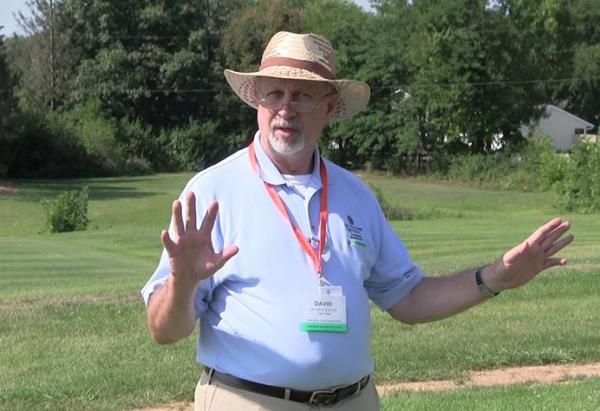It says right in the second paragraph of the U.S. Declaration of Independence that "all men are created equal," but you don't have to listen to Ohio State professor Karl Danneberger, Ph.D., talk for even that long to know that all plant growth regulators are not.
 "When people say all plant growth regulators are the same, they are not the same," Danneberger said during a PGR update at this week's Ohio Turfgrass Foundation turf research field day.
"When people say all plant growth regulators are the same, they are not the same," Danneberger said during a PGR update at this week's Ohio Turfgrass Foundation turf research field day.Danneberger's talk focused primarily on the PGRs that work as gibberellic acid inhibitors: paclobutrazol, trinexapac-ethyl and flurprimidol. As different PGRs with different active ingredients and different modes of action made it to market in during different stages, it took research and a lot of trial and error to come to that conclusion. It also took the advent of one product in particular in the 1990s.
"It's interesting to see how they've been used, how they've adapted and how we stand with them now," Danneberger said.
"When Primo came out (Syngenta's) Joe DiPaola came around to market it . . . I go ' geez, Joe, just another PGR.' But it did revolutionize how we use PGRs."
Held at the OTF Turfgrass Research and Education Facility at Ohio State University, the field day included tours on topics such as wetting agent performance, sprayer calibration, summer weed identification and control, annual bluegrass weevil update as well as updates on fungicide programs for disease control.
Between Danneberger and his recently retired colleague John Street, Ph.D., an awful lot of PGR research has been conducted at Ohio State, including early work on why trinexapac-ethyl is more effective in cooler conditions than it is during the middle of summer and why paclobutrazol is such a good tool to use during fairway conversion projects.
Because trinexapac-ethyl is foliar absorbed, the half life is severely affected by severe summer conditions.
"It just disappears," Danneberger said. "Whether it's metabolized quickly, or just broken down, it's gone."
A rule of thumb, says Danneberger, is to use trinexapac-ethyl if managing for Poa and paclobutrazol, which has a systemic mode of action, if managing for creeping bentgrass.
Danneberger said he suggests maintaining a seven-day program for Poa greens.
But what about places with a mix of bent and Poa?
The generally accepted program, he said, was to use trinexapac-ethyl in spring for seedhead control and switch to paclobutrazol in summer at 2 to 4 ounces, with increased rates of 8 to 16 ounces heading into fall.
"I had friends at the USGA who swore by that, except every course I went to, I didn't see that," Danneberger said. "I tried it, and I didn't get that, so I've been playing around with that this year and said 'forget it,' and look at those 32- and 64-ounce rates and bring back memories and relive my younger days."
As with any program that controls Poa, it's best to know how much you really have, especially when dropping a systemic PGR with two weeks of residual activity like paclobutrazol.
"That turns Poa yellow, and when it gets really hot, it kind of dies," he said. "So, keep that 14-day soil-absorption rule in mind, because you're going to be coming in and seeding."
Annual bluegrass weevil update
 Like plant growth regulators, all species of annual bluegrass weevil are not created equally. ABW slowly is making inroads into Ohio's northern tier, but it's a different animal, literally, than what superintendents are battling in the country's northeastern corridor.
Like plant growth regulators, all species of annual bluegrass weevil are not created equally. ABW slowly is making inroads into Ohio's northern tier, but it's a different animal, literally, than what superintendents are battling in the country's northeastern corridor.In many parts of the Northeast, annual bluegrass weevil species have developed resistance to one of the superintendent's favorite tools - bifenthrin, a pyrethroid class insecticide.
"There are records of superintendents applying bifenthrin eight to 10 times in a single season," Shetlar said.
"When you hit an insect repeatedly with the same insecticide and have multiple generations per year, you're going to develop resistance."
The ABW species found in northeastern Ohio still are quite susceptible to pyrethroids, something Shetlar learned when he first visited a Cleveland-area golf course a few years ago.
"I was shocked the first time we ran into it," he said. "We came with all these studies of everything we could think of, and Talstar kicked butt."
Still, the absence of resistance to pyrethroids makes ABW management in Ohio much easier than say in New Jersey or New York.
"But a word of caution," he said. "Even though weevils in Ohio are not resistant to bifenthrin, you have to have a program that alternates another chemistry with bifenthrin so they don't develop resistance."
Among the products Shetlar recommends for Ohio turf managers are pyrethroids such as deltamethrin and Lambda- cyhalothrin.
A pyrethroid coupled with chlothianidin applied two times over a three-week window in the spring is an effective combination in the fight against ABW in Ohio.
"We do a soap flush in the spring in mid- to late April. When we detect adults migrating out of the turf, we make the first application, and mark that on the calendar," Shetlar said. "We make the second application three weeks later then we're done for the season. That's it. What we find, since adults are not resistant to bifenthrin, it takes out any adults that are out there, and the chlothianidin component of that is systemic. I know it's a neonicotinoid, but it works well at taking out the larvae."
Some have asked Shetlar if he thought two applications was overkill, no pun intended.
"The thought has been that movement may occur over a two-week period. The more we study it, the adult migration might occur over a six-week period. By making the first application we take out the first migrants and the first larvae. By making the second application three weeks later, it takes out the rest of the migrants that have moved in, and if they've survived, we take them out for another three weeks. This way, we cover that six-week window where these critters can come into the turfgrass."

